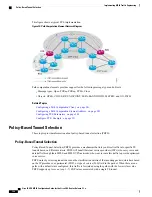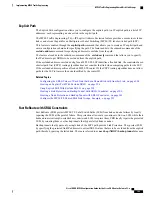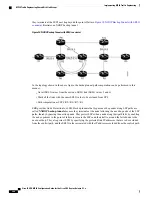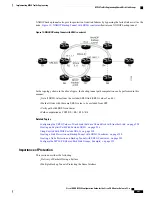
Explicit Path
The Explicit Path configuration allows you to configure the explicit path. An IP explicit path is a list of IP
addresses, each representing a node or link in the explicit path.
The MPLS Traffic Engineering (TE)
—
IP Explicit Address Exclusion feature provides a means to exclude a
link or node from the path for an Multiprotocol Label Switching (MPLS) TE label-switched path (LSP).
This feature is enabled through the
explicit-path
command that allows you to create an IP explicit path and
enter a configuration submode for specifying the path. The feature adds to the submode commands of the
exclude-address
command for specifying addresses to exclude from the path.
The feature also adds to the submode commands of the
exclude-srlg
command that allows you to specify
the IP address to get SRLGs to be excluded from the explicit path.
If the excluded address or excluded srlg for an MPLS TE LSP identifies a flooded link, the constraint-based
shortest path first (CSPF) routing algorithm does not consider that link when computing paths for the LSP.
If the excluded address specifies a flooded MPLS TE router ID, the CSPF routing algorithm does not allow
paths for the LSP to traverse the node identified by the router ID.
Related Topics
Configuring the SRLG Values of Each Link that has a Shared Risk with Another Link, on page 294
Creating an Explicit Path With Exclude SRLG, on page 296
Using Explicit Path With Exclude SRLG, on page 298
Creating a Link Protection on Backup Tunnel with SRLG Constraint, on page 300
Creating a Node Protection on Backup Tunnel with SRLG Constraint, on page 303
Configure the MPLS-TE Shared Risk Link Groups: Example, on page 353
Fast ReRoute with SRLG Constraints
Fast ReRoute (FRR) protects MPLS TE Label Switch Paths (LSPs) from link and node failures by locally
repairing the LSPs at the point of failure. This protection allows data to continue to flow on LSPs, while their
headend routers attempt to establish new end-to-end LSPs to replace them. FRR locally repairs the protected
LSPs by rerouting them over backup tunnels that bypass failed links or nodes.
Backup tunnels that bypass only a single link of the LSP's path provide Link Protection. They protect LSPs
by specifying the protected link IP addresses to extract SRLG values that are to be excluded from the explicit
path, thereby bypassing the failed link. These are referred to as
next-hop (NHOP) backup tunnels
because
Cisco IOS XR MPLS Configuration Guide for the Cisco CRS Router, Release 5.1.x
199
Implementing MPLS Traffic Engineering
MPLS Traffic Engineering Shared Risk Link Groups





































